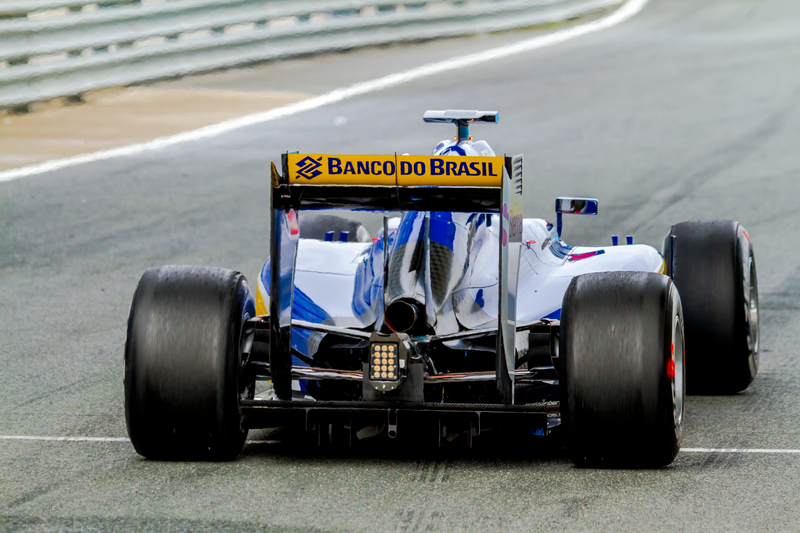Last updated on October 30th, 2023 at 12:37 pm
The drag reduction system (DRS) in F1 cars is specifically a portion of the rear wing that opens to reduce aerodynamic drag on the vehicle. This system increases a car’s top speed by about seven miles per hour, giving drivers the boost to overtake an opponent. Some fans and commentators call the flap that opens the “mail slot” in the rear wing since it resembles a slot you’d see in a door or mailbox.
This system’s design improves overtaking in the sport by giving an F1 driver a slight advantage in straight-line speed over a car they’re following closely behind. Many other racing federations have similar innovations to encourage overtaking, as it’s one of the most exciting parts of motorsports.
When Did DRS Enter Formula One?
DRS was first allowed in Formula One in 2011. Implementing the DRS technology required changing FIA rules regarding aerodynamic packages on a car. Historically, pieces of the vehicle that managed downforce could not move for safety reasons. However, with improvements to technology, teams could implement DRS without impacting the car’s stability.
When Can Drivers Activate DRS?
Drivers aren’t able to activate DRS whenever they want. Each track has several designated DRS zones, which are areas where this system can be activated. Drivers can select when they turn on DRS if they’re eligible. A light on the dashboard illuminates to inform drivers when DRS is available, and they can turn it on at will using a button on their steering wheel if they’re within a DRS zone.
DRS isn’t active during the entirety of a race. The system turns on two laps after the start of the race. The use of DRS also isn’t available for the first two laps after a yellow flag, a safety car, or a red flag restart. Finally, the race director can limit DRS use during races with dangerous conditions, like heavy rains.
What are the Factors When a Driver Will Have DRS Available?
Several factors dictate whether or not a driver will have DRS available. For example, DRS is available freely during qualifying sessions so drivers can lay down the fastest lap possible. However, during an F1 race, the use of this feature is much more restricted. DRS is only available if a car follows within one second of the car in front of them when they pass a DRS detection point. These activation zones are marked out on the track and are generally just before the DRS zone.
Many drivers know the DRS activation zones and will use them when driving. For example, in the 2022 Saudi Arabia Grand Prix, Ferrari’s Charles Leclerc and Red Bull’s Max Verstappen were racing to the finish neck and neck. As the drivers approached the DRS detection point, they slammed their brakes to avoid being the first one over the line. Crossing the detection point first would give the following car DRS over them, making it easy to overtake on the next straightaway.
Where are DRS Zones on a Track?
Since activating the DRS system impacts the downforce on a car, DRS use is restricted to straightaways. The lack of downforce can make it harder for cars to handle and corner, resulting in locking the breaks or sliding in turn. The new aerodynamic regulations released in recent years have made it easier for vehicles to use DRS without losing much stability. They rely much more heavily on ground effects for good handling.
Every F1 track has at least one DRS zone, though many have at least two or three. DRS has much more impact on high downforce tracks like Singapore or Monaco overpower tracks like Monza, Saudi Arabia, or Bahrain. Low-downforce, power tracks are designed to produce less drag on the vehicles, which means they benefit less from drag reduction.
Why is DRS Necessary?
The FIA instituted DRS as a way to make racing more exciting. Before releasing the 2022 regulations, which allowed cars to use ground effects for stability, vehicles had difficulty following one another closely. As a car pushes through the air, it leaves a turbulent wake behind it, often called “dirty air.” That patch of turbulent air affects how the next car handles it and can also cause brakes and tires to overheat, impacting stopping ability.
The widespread use of DRS encourages side-by-side racing. Since a trailing car can challenge a leading vehicle, drivers can enter an evenly-matched braking zone. That creates an exciting spectacle, meaning any driver can win a race or compete in the World Championship.
Conclusion: What is DRS in F1?
Next time the driver from your favorite F1 team tears down the straightaway behind their rival, pay close attention to their rear wing. If they’re following closely enough, you should see a slot in their rear wing open up, allowing them to take advantage of a boost of speed from their drag reduction system.
DRS is one of the most exciting innovations to come out of Formula 1 in the past decade. That means races are more competitive, and more drivers have an opportunity to stand on the podium.
Similar Posts:
What Does Interval Mean in F1?
Why Do F1 Drivers Get Weighed After Races?
How Many Laps in a NASCAR Race?
What is the Difference Between NASCAR
How Many Cars are in a NASCAR Race?
What is the Difference Between NASCAR and F1?
How Do You Become a NASCAR Driver?
Greg Kristan, owner of The Stadium Reviews, LLC and TM Blast, LLC, brings his extensive experience visiting over half of the MLB ballparks, along with numerous MLS, NHL, NBA, and NFL venues, to provide in-depth coverage on the bag policy, food options, and parking. He has also been interviewed about his experiences on several sports podcasts.







